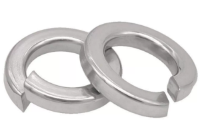internal external tooth lock washer factory
Internal and External Tooth Lock Washers A Comprehensive Overview of Their Manufacturing
Lock washers are essential components in mechanical assemblies, providing frictional resistance and preventing loosening of fasteners under dynamic loads. Among the various types of lock washers, internal and external tooth lock washers are particularly popular due to their unique designs and effectiveness. This article explores the manufacturing process, uses, and benefits of internal and external tooth lock washers, shedding light on a factory specializing in their production.
Understanding Internal and External Tooth Lock Washers
Internal Tooth Lock Washers These washers feature teeth on the inner circumference, designed to grip the fastener. When installed, the teeth dig into the surface of the fastener, providing a secure fit. This design is especially useful in applications where space is limited, as the teeth do not extend beyond the outer diameter of the washer.
External Tooth Lock Washers Contrary to their internal counterparts, external tooth lock washers boast teeth around the outer circumference. The teeth engage with the surface of the material being fastened, which helps prevent the fastener from loosening due to vibrations or shock loads. These washers are ideal for applications with larger clearances or where more surface area is required to ensure stability.
The Manufacturing Process
The production of internal and external tooth lock washers involves several key steps, ensuring precision and durability in the final products. Here's a brief outline of the manufacturing process typically seen in a dedicated lock washer factory
1. Material Selection The first step involves selecting high-quality materials. Stainless steel, carbon steel, and alloy steel are commonly used due to their strength and resistance to corrosion.
2. Cutting and Shaping After selecting the raw material, sheets of metal are cut into appropriate shapes based on the specifications for internal or external tooth lock washers. This process may involve stamping or laser cutting.
3. Forming Teeth For internal tooth lock washers, the teeth are formed on the inner edge. For external tooth washers, the teeth are shaped on the outer perimeter. This is typically achieved through a combination of stamping and pressing techniques that create precise and consistent teeth profiles.
internal external tooth lock washer factory

4. Heat Treatment To enhance the mechanical properties of the washers, heat treatment processes like quenching and tempering are applied. This step increases the strength and flexibility of the washers.
5. Surface Treatment For added protection against corrosion and wear, washers undergo surface treatments such as plating, coating, or passivation. These treatments not only extend the lifespan of the washers but also improve their overall appearance.
6. Quality Control Rigorous testing and inspection are conducted throughout the manufacturing process. This ensures that the washers meet industry standards and specifications regarding dimensions, strength, and durability.
7. Packaging and Distribution Once the manufacturing and quality control processes are completed, the lock washers are packaged carefully to prevent damage during transportation. They are then distributed to various industries, including automotive, aerospace, and construction.
Uses and Benefits
Internal and external tooth lock washers are utilized across numerous sectors due to their effectiveness in preventing loosening of fasteners. They are particularly useful in high-vibration environments, such as automotive assemblies or industrial machinery. The primary benefits of using these washers include
- Enhanced Reliability Lock washers provide a dependable solution for maintaining torque and tension, reducing the likelihood of fastener failure.
- Cost-Effectiveness By preventing loosening and minimizing the risk of failures, these washers contribute to lower maintenance costs and downtime.
- Versatility Available in various sizes and materials, internal and external tooth lock washers can be adapted for numerous applications, making them an indispensable choice for engineers and manufacturers.
In conclusion, internal and external tooth lock washers play a critical role in mechanical applications. Understanding their manufacturing process and benefits highlights the importance of specialized factories in producing high-quality components that contribute to the efficiency and reliability of modern machinery. As industries continue to evolve, the demand for these essential locking devices will only grow, showcasing their integral position in engineering and manufacturing.
-
Top Choices for Plasterboard FixingNewsDec.26,2024
-
The Versatility of Specialty WashersNewsDec.26,2024
-
Secure Your ProjectsNewsDec.26,2024
-
Essential Screws for Chipboard Flooring ProjectsNewsDec.26,2024
-
Choosing the Right Drywall ScrewsNewsDec.26,2024
-
Black Phosphate Screws for Superior PerformanceNewsDec.26,2024
-
The Versatile Choice of Nylon Flat Washers for Your NeedsNewsDec.18,2024










